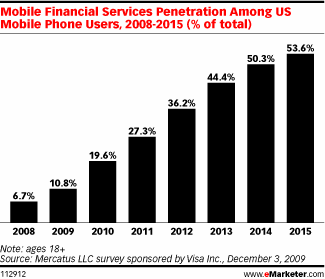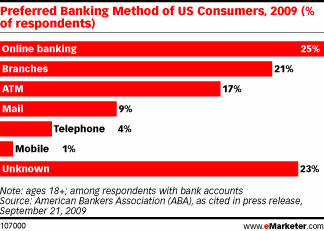Since 2008, consumers have been moving from brick-and-mortar banking to online banking at an impressive rate. This trend is welcomed not only by consumers who like the convenience of anytime banking, but also by financial institutions that like to streamline operations and cut down costs.
Several forecasts predict that by 2015, 50% or more of US mobile users will be conducting transactions from their mobile devices (e.g. opening an online savings account).

There are many critics that point out that will not happen. According to a survey commissioned by identity protection services firm Kindsight, nearly two-thirds of respondents worried that banking, credit card or other personal info could be stolen from their computers. Bloomberg Businessweek joins the pack of critics with a July 2010 report claiming that “Gen Y lacks confidence about making financial decisions”. As an example, Bloomberg Businessweek cites that fewer than 4,000 Facebook users have clicked the “like” button for Fidelity’s Page and about 9,000 have done so for Vanguard’s. Meanwhile 4.2 million people say they like Apple iTunes on Facebook. As another example, Schwab, which began sending Twitter feeds in mid-June 2010, has 277 followers. The WholeFoods Twitter account has 1.8 million followers.
What Bloomberg Businessweek and other critics fail to understand is that social media activity is not a proper way to measure whether members of Generation X and Y are accessing their bank accounts mostly online. You need to look at the bigger picture, which is formed mainly by 2 factors: 1) preferred banking method of Generation X and Generation Y, and 2) activities least likely to give up for a week by Generation X and Y.
1. Preferred Banking Method by Generation X and Y
According to an August 2009 survey of US consumers by the American Bankers Association (ABA), online is now the No. 1 method of banking. 1/4 of respondents preferred banking online to using branches, ATMs or any other channel.

Generation Y is leading the pack in online banking. According to financial technology provider Fiserv, nearly one-half of Generation Y Internet users planned to sign up for a new financial account in the next year.

2. Activities Least Likely to Give Up for a Week by Generation X and Y
Consider this:

There may be reporting on the demise of e-mail due to the rise of social media, however college students still see e-mail and SMS as critical mediums for online communication.
Yes, it is hard to imagine but people can do longer without social networking sites than without e-mail. This is a key point that the Bloomberg Businessweek July 2010 overlooked.
More importantly:

Despite their comfort with the Web and online banking, Generation X and Y are most likely to get advice about financial products (e.g. opening a money market account) from friends and family or a significant other than from an online community. Therefore, it makes sense that only 4,000 Facebook users have clicked the “like” button for Fidelity’s Page.
Conclusion
In general, more experienced web users have fewer security concerns—like the Gen X and Y who are savvy enough online to know how to protect their privacy. Given that: 1) younger users are least likely to give up e-mail and text messaging for a week, and 2) about 1/4 of consumers prefer online banking the most; US mobile users will be conducting transactions from their mobile devices much more regularly.

I too completely agree with all these points. In past 5 years, I have visited the bank only thrice..